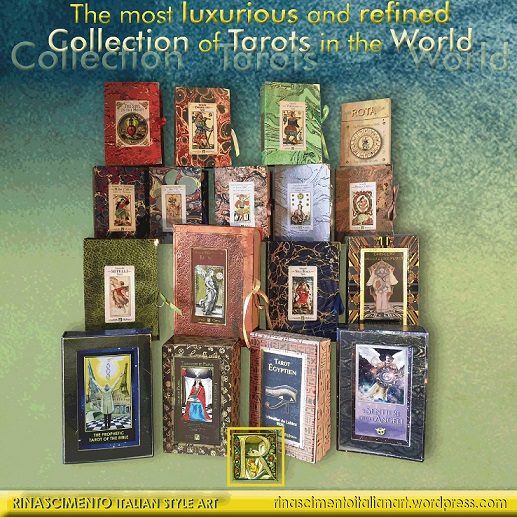Rinascimento Italian Style Art is an project created in 2014 by historian of esotericism in art Giordano Berti together with art designer Letizia Rivetti.
This project is aimed at the historical study and reprinting of ancient Tarots, rare playing cards and oracular decks.
“Rinascimento project” has obtained the valuable collaboration of the Academy of Sciences in Turin and the British Museum in London, as well as private collectors and researchers in various fields of knowledge.
All the works of art are printed in a limited edition, absolutely faithful to the originals and enriched by unpublished historical studies. The splendid box for the decks are precious treasure chests produced by expert Italian artisans, avoiding the use of plastic and harmful inks.
It is no coincidence that the products created by Rinascimento are defined by experts as “the most luxurious and refined collection of Tarot and Sibyls in the worldì”.
WEBSITE: https://rinascimentoitalianartenglish.wordpress.com/
SOME DECKS OF OUR PRODUCTION
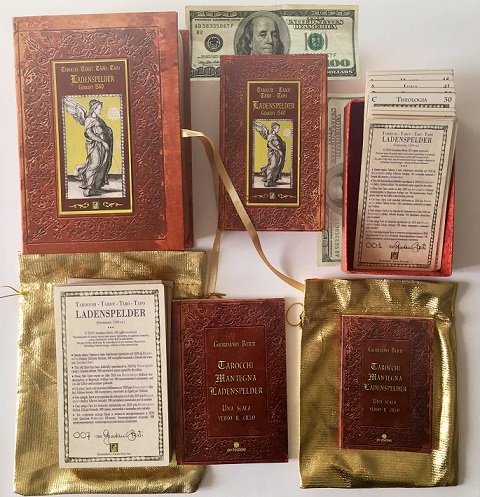
The Mantegna-Ladenspelder Tarot back to light after 480 years
These 50 splendid cards, once attributed to the great Andrea Mantegna, are one of the most enigmatic creations of Renaissance art.
This Work of Art was created in Ferrara (Northern Italy) around 1460-65 and re-engraved in Germany by Johann Ladenspelder around 1540.
The Mantegna-Ladenspelder Tarot is re-proposed in two versions (Deluxe and Art Box) which enhance its beauty, nobility and profound spirituality.
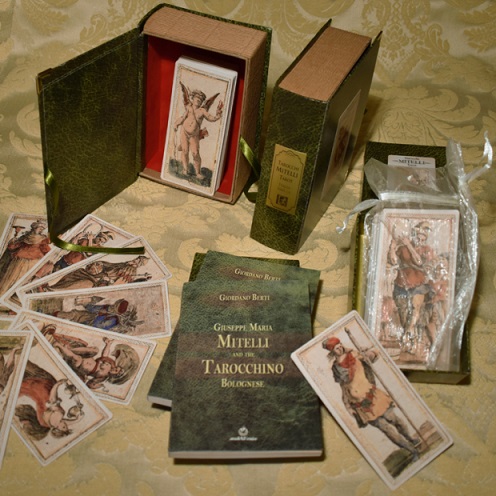
Giuseppe Maria Mitelli, Card Game, with a new form of Tarocchini
Around 1660, italian engraver and creator of board games Giuseppe Maria Mitelli (Bologna 1634 – 1718), produced a true masterpiece of Baroque art for Count Filippo Bentivoglio.
That deck was titled “Giuoco di Carte, con nuova forma di Tarocchini” (Card Game, with a new form of Tarocchini). It consisted in six sheets with two groups of eleven cards and four groups of ten cards, for an amount of 62 cards.
This is the Tarocchino bolognese, absolutely identical to the traditional pack of Tarocchi except for the elimination of 16 cards: 2, 3, 4 and 5 of each suite.
Obviously, to use these cards it was necessary to cut them out and stick them on sturdy cardboard. There are documents confirming this use, but no traces remain of the colored decks produced at the time of Mitelli. Remains just some complete series of the uncut sheets and some illustrated books.
In fact, there was someone who, fascinated by the beautiful of these cards, commissioned a painter to color them and then mounted the single cards on the pages of a book, to admire without ruining them.
Some of that books belonged to noble Bolognese families and now are kept in various public and private collections.
A few decades after Mitelli’s death, most precisely around 1750, an anonymous Bolognese card-maker, signed ALLA TROMBETTA, reprinted and hand-painted the 62 cards in a number unknown of copies, putting them on the market for use by the card-players.
One of these decks, now kept at the National Library of Paris, has been faithfully reprinted in 2017 in its original dimensions and colors, under the artistic direction of Giordano Berti.
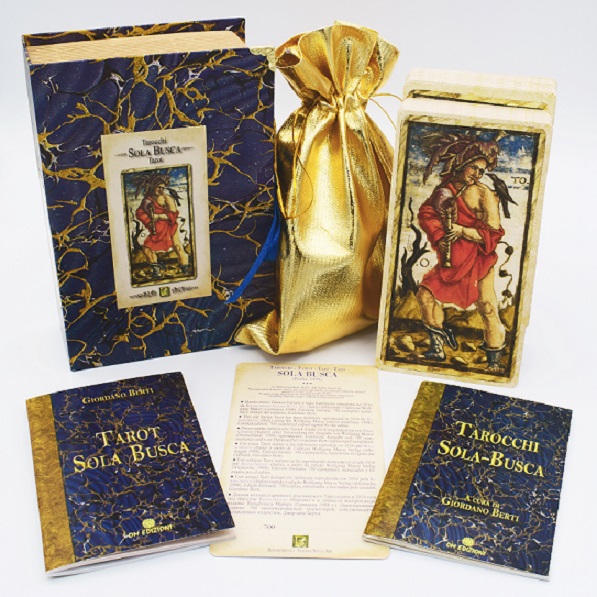
Sola Busca Tarot, XVth century
The Sola Busca is the only Tarot deck of the 15th century that has come to our day complete with all 78 cards.
According to recent studies it was created around 1491 by the painter Nicola di Maestro Antonio, who undoubtedly translated into images an iconographic project of a hermeticist that some identify with Ludovico Lazzarelli. In fact, this is the first alchemical deck in history and the first deck that has all 78 cards illustrated with dynamic characters and complex scenes.
The 22 Triumphs depicting heroes of Greek and Roman history and, in two cases, of biblical story: Nenbroto (Nimrod) and Nabuchodenasor (Nebuchadnezzar).
The Court Cards and Numerals show scenes of daily life, images of fantasy and alchemical allegories.
The symbols are slightly different from the traditional ones: Disks instead of Coins, Clubs instead of Wands; Amphorae instead of Cups. Swords remain Swords.
At the beginning of the twentieth century, the English esotericist Arthur Edward Waite had the opportunity to see these cards and take inspiration to create some images for the Rider-Waite Tarot painted by Pamela Colman Smith.
The Rinascimento Italian Style Art edition (700 numbered copies) is the only one that, in terms of colors and sizes, is absolutely faithful to the original cards now kept at the Brera Gallery, in Milan.
Attached to the deck is a booklet by Giordano Berti which summarizes the history and meanings of these splendid cards.
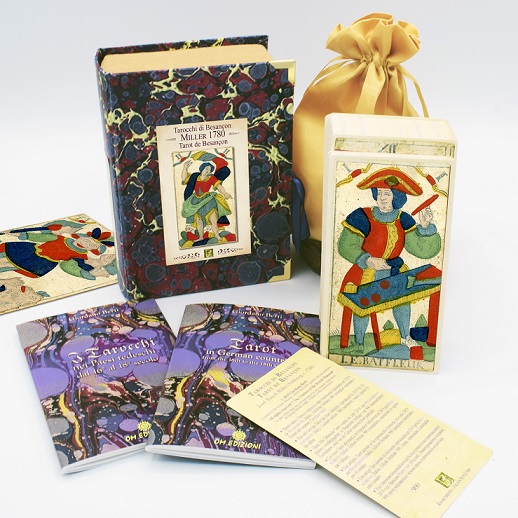
Tarot of Besançon
The Tarot called "of Besançon is an extremely fascinating chapter in the history of the Tarot. In essence, it is a classic Marseille Tarot where the Popess and the Pope were replaced by the Greek gods Juno and Jupiter.
Actually, the Tarot of Besançon was not invented in the capital of Burgundy but in Strasbourg, Alsace, around 1715. From Alsace this model spread to Switzerland, eastern France and the German countries, where local card makers adapted the original images to their own style.
Among the most beautiful decks, the one created in Salzburg around 1780 by Josef Rauch Miller stands out. Miller's is considered one of the most splendid Tarot decks of the eighteenth century.
Miller’s Tarot, now in the British Museum in London, has been reproduced by Rinascimento Italian Style Art in an absolutely faithful way to the original deck in all details: colors, dimensions and back of the cards. The typical defects of the production of playing cards in the eighteenth century were also deliberately preserved.
The deck has been printed on special cotton paper in a limited edition of 900 copies numbered and signed on a guarantee card.
The deck is accompanied by a historical study, The Tarot in German countries from the 16th to the 18th century, written by Giordano Berti, which reports all the essential elements of that tradition.
The cards comes in a refined book-shaped box, created by the art designer Letizia Rivetti and produced by expert Italian craftsmen.
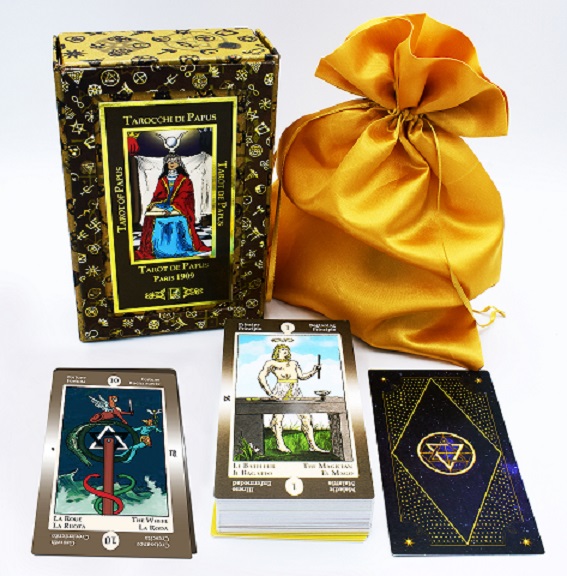
Kabbalistic Tarot of Papus
Papus was the most prolific popularizer of the esoteric traditions of the twentieth century.
He is also responsible for this marvelous deck which contains both the cartomantic tradition and the esoteric mysticism that sees in the Tarot the paths that lead to lost Paradise.
After 110 years from the first publication in Le Tarot divinatoire, the Tarot of Papus returns to light in a new guise that accentuates its cabalistic charm.
The cards, originally in black and white, have been reprinted in 2019 by Rinascimento Italian Style Art, in a spectacular color version edited by the esoteric historian Giordano Berti.
A particular color distinguishes the frame and each seed, based on the alchemical-kabbalistic-astrological tradition.
The 78 cards show the divining meanings in four languages: French, Italian, English and Spanish.
The deck was produced in two versions, Deluxe and Art Box, both in a limited edition of 900 numbered copies.
